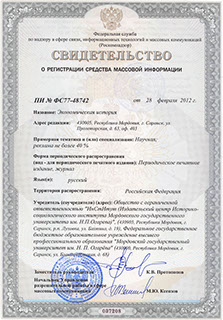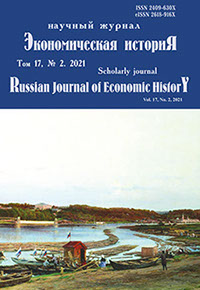Экономическая историЯ
Russian Journal of Economic History
ISSN 2409-630X (Print)
ISSN 2618-916X (Online)
Expert board:
- Scientific Council of RAS on economic history;
- Research and Educational Center «The economic history of Central Russia and the Middle Volga region» of Ogarev Mordovia State University;
- Center of Economic History of Lomonosov Moscow State University
Navigation
Certificate of registration

ISSN 2409-630X (Print), ISSN 2618-916X (Online)
DOI: 10.15507/2409-630X.053.017.202102.144-160
УДК 94(470.5)“18/19”
Georgy N. Shumkin
Institute of History and Archeology of the Ural branch of the Russian Academy of Sciences (Yekaterinburg, Russia),
e-mail: shumk@mail.ru
The Vector of Equal Costs as a Method of Studying the Process of Industrialization (according to labor productivity data in the iron and steel industry of the Urals of the late XIX – early XX centuries)
Introduction. An attempt is made to analyze the dynamics of labor productivity in the iron-making industry of the Urals using the equal cost vector during the replacement of welding iron production technologies with cast steel production technologies in open-hearth and Bessemer furnaces, as well as to determine the heuristic potential of this method. Materials and Methods. The study uses a vector of equal costs. This vector connects the points on the graph that reflect the number of two products released per unit of resource for a certain period of time. The source of the study was the “Collections of statistical data of the mining industry of Russia”. Results. The vectors of equal costs for the production of iron and steel per worker of the iron- making industries of the Urals in 1893–1911 are constructed. The periods in the development of iron-making production are highlighted. Discussion and Conclusion. The method of equal cost vectors revealed the following: 1) rational use of labor in private factories and irrational in state-owned ones; 2) significant influence of the Nadezhdinsky Plant on the structure of iron-making industries; 3) a more precise chronological framework for the replacement of welding iron production technologies by open-hearth and seedless production, the influence of market conditions on this process; 4) the replacement of old technologies with new ones did not cause an increase in productivity. It was also found that equal cost vectors can be used as a tool for verifying data from statistical sources.
Keywords: methodology, industrialization, labor productivity, production possibility curve, mining industry, Urals, vector of equal costs, ferrous metallurgy.
For citation: Shumkin G. N. The Vector of Equal Costs as a Method of Studying the Process of Industrialization (according to labor productivity data in the iron and steel industry of the Urals of the late XIX – early XX centuries). Ekonomicheskaya istoriya = Russian Journal of Economic History. 2021; 17(2): 144–160. (In Russ.). DOI: 10.15507/2409-630X.053.017.202102.144-160.
© Ogarev Mordovia State University. History and Sociology Institute, 2017
68, Of. 411, Bolshevistskaya St., 430005, The editorial office of the scholarly journal «Russian Journal of Economic History»
Tel.: (8342) 24-25-90; 27-07-11, Fax: (8342) 24-25-90, E-mail: jurnal-econom-hist@isi.mrsu.ru
Designed by A. Napalkov, Email: napalkov@isi.mrsu.ru

